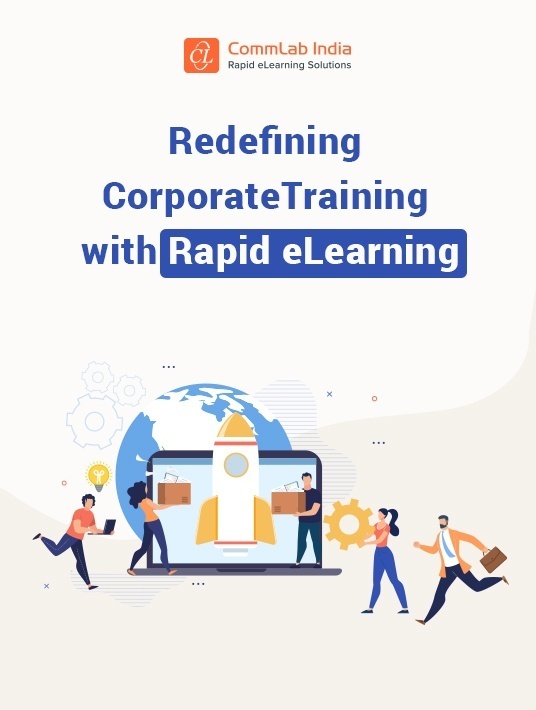Why You Need Rapid eLearning
Are you worried that your current eLearning development is costing a lot of time, effort, and dollars? Are you going around with a permanent frown thinking of ways to minimize these costs? Get started with rapid eLearning development and bid goodbye to budget and timeline woes.

The idea behind rapid eLearning is to build and roll out eLearning courses quickly, within weeks instead of months. It’s the best way to offer time-critical training to your employees. Rapid eLearning offers many more benefits that make it a must for corporate training. Let’s look at some of them.
5 Compelling Reasons To Seal The Deal On Rapid eLearning Development
While conventional eLearning involves developing courses from scratch, rapid eLearning leverages existing content, sound Instructional Design, and rapid authoring tools to create courses quickly and effectively [1].
1. Create eLearning Courses Quickly, Using Existing Content
Your organization is bound to have an archive of training materials—PDFs, classroom handouts, PowerPoint presentations, instructor manuals, and more. With rapid eLearning, you can convert these existing classroom materials into engaging eLearning courses, saving both time and money.
Rapid eLearning also allows you to repurpose and transform existing content into microlearning assets modern learners prefer [2]—videos, audio podcasts, infographics, interactive eBooks, micro-quizzes, and many more. The amount of reusable training material available is inversely proportional to the time it takes for rapid eLearning development. However, these existing materials need a lot of refining before they become eLearning ready.
This is where eLearning vendors with expertise in Instructional Design can help. These vendors analyze your existing training content against the training requirements, fill gaps, apply new-age Instructional Design strategies, and use the latest rapid eLearning authoring tools for quick course development.
2. Offer A New Lease Of Life To Flash-Based Courses
Flash is going to be obsolete by the end of 2020. This means you are only left with a few months to convert your Flash-based courses to HTML5 [3]. You can’t continue to use Flash-based courses because of Flash’s incompatibility with mobile devices and modern-day web browsers. Now, this is a deal-breaker for organizations with a millennial workforce, who prefer to learn on-the-go and who need access anytime, anywhere.
HTML5-based eLearning offers multi-device and browser compatibility, allowing learners to access learning whenever needed on their mobile devices. If your organization has a library of Flash-based eLearning courses, you can now easily convert them into HTML5 format with rapid eLearning authoring tools.
Even if you don’t have the source files of these legacy courses, competent eLearning vendors can still convert them into HTML5, using the latest rapid eLearning authoring tools such as Articulate Storyline 360, Adobe Captivate, Lectora Online, and iSpring Suite.
3. Make Training Global For Learners Across The Globe
If your workforce is spread across the globe, eLearning translations will help you impart consistent and culturally relevant training. Although the idea of in-house translation might seem economical [4], it comes with its fair share of challenges that make it time-consuming and ineffective—for instance, lack of expertise in the topic and set processes.
To make things easier and faster, choose an eLearning vendor who also offers eLearning translations. Ensure the vendor has a pool of translators proficient in using the latest authoring and memory tools and that they also have language experts. This saves time while ensuring quality and consistency.
4. Save Time And Cost In Design And Development
To reiterate, rapid eLearning development takes less time and hence costs less than conventional eLearning development. However, which are the reasons behind the rapidity of rapid eLearning? Here are some of them:
- Working with Subject Matter Experts (SMEs) to filling gaps in existing content [5]; this allows the Instructional Design team to start with storyboards right away.
- Following checklists and style guides to minimize the chances of errors and rework.
- Leveraging the features of authoring tools such as customizing templates for a faster turnaround—since coding isn’t involved.
- Using online review tools such as Articulate Review to speed up the review and feedback cycle.
- Standardizing and reusing elements such as audio clips of instructions, graphical elements, animations, and interactivities.
5. Update Courses At The Speed Of Need
Rapid authoring tools—Storyline 360, Adobe Captivate, Lectora Inspire, iSpring, dominKnow—enable updating, recreating, and refreshing existing courses quickly so that you can easily update your training to reflect the latest changes in industrial regulations, policies, or market trends with rapid eLearning.
With rapid eLearning authoring tools, changes can be done without having to design the courses all over again, saving on resources and time, and therefore money. Moreover, because of the ease of use, updates can even be done in-house rather than going back to the vendor.
It's A Wrap
According to a report by ATD [6], an average of 42-71 development hours were required to create one hour of training with level 1 and 2 interactions. The report also shows a trend of declining development hours, thanks to the advancements in technology, which allows developers to automate tasks that previously needed coding. However, with rapid eLearning, you can reduce the development time by up to 40%.
So, your hunt for a perfect solution for "immediate training needs" ends with rapid eLearning development. Whether you have a few courses or a hundred, or even a library of them, rapid eLearning can take care of everything for you! Download the eBook Redefining Corporate Training With Rapid eLearning and join the webinar to get the chance to incorporate modern learning strategies into your training quickly and easily.
References:
[1] 5 eLearning Authoring Tools that Will Rule in 2019
[2] Microlearning to Boost Employee Performance
[3] Flash to HTML5 Conversion Process: A Ready Reckoner
[4] Lost in E-learning Translation: Should Employees Double up as Translators?
[5] Saving SME Time in eLearning? It’s Easy if You Do it Smart! [Video]
[6] How Long to Develop One Hour of Training? Updated for 2017

